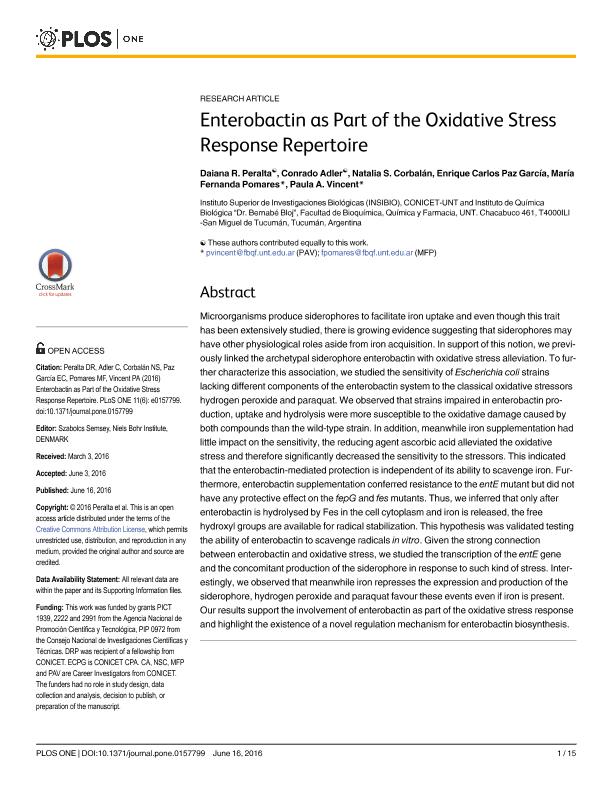Mostrar el registro sencillo del ítem
dc.contributor.author
Peralta, Daiana Romina

dc.contributor.author
Adler, Conrado

dc.contributor.author
Corbalan, Natalia Soledad

dc.contributor.author
Paz García, Enrique Carlos

dc.contributor.author
Pomares, Maria Fernanda

dc.contributor.author
Vincent, Paula Andrea

dc.date.available
2018-07-11T20:16:04Z
dc.date.issued
2016-06
dc.identifier.citation
Peralta, Daiana Romina; Adler, Conrado; Corbalan, Natalia Soledad; Paz García, Enrique Carlos; Pomares, Maria Fernanda; et al.; Enterobactin as part of the oxidative stress response repertoire; Public Library of Science; Plos One; 11; 6; 6-2016; 1-15; e0157799
dc.identifier.issn
1932-6203
dc.identifier.uri
http://hdl.handle.net/11336/51796
dc.description.abstract
Microorganisms produce siderophores to facilitate iron uptake and even though this trait has been extensively studied, there is growing evidence suggesting that siderophores may have other physiological roles aside from iron acquisition. In support of this notion, we previously linked the archetypal siderophore enterobactin with oxidative stress alleviation. To further characterize this association, we studied the sensitivity of Escherichia coli strains lacking different components of the enterobactin system to the classical oxidative stressors hydrogen peroxide and paraquat. We observed that strains impaired in enterobactin production, uptake and hydrolysis were more susceptible to the oxidative damage caused by both compounds than the wild-type strain. In addition, meanwhile iron supplementation had little impact on the sensitivity, the reducing agent ascorbic acid alleviated the oxidative stress and therefore significantly decreased the sensitivity to the stressors. This indicated that the enterobactin-mediated protection is independent of its ability to scavenge iron. Furthermore, enterobactin supplementation conferred resistance to the entE mutant but did not have any protective effect on the fepG and fes mutants. Thus, we inferred that only after enterobactin is hydrolysed by Fes in the cell cytoplasm and iron is released, the free hydroxyl groups are available for radical stabilization. This hypothesis was validated testing the ability of enterobactin to scavenge radicals in vitro. Given the strong connection between enterobactin and oxidative stress, we studied the transcription of the entE gene and the concomitant production of the siderophore in response to such kind of stress. Interestingly, we observed that meanwhile iron represses the expression and production of the siderophore, hydrogen peroxide and paraquat favour these events even if iron is present. Our results support the involvement of enterobactin as part of the oxidative stress response and highlight the existence of a novel regulation mechanism for enterobactin biosynthesis.
dc.format
application/pdf
dc.language.iso
eng
dc.publisher
Public Library of Science

dc.rights
info:eu-repo/semantics/openAccess
dc.rights.uri
https://creativecommons.org/licenses/by/2.5/ar/
dc.subject
Enterobactin
dc.subject
Oxidative Stress
dc.subject
Escherichia Coli
dc.subject
Hydrogen Peroxide
dc.subject
Vitamin C
dc.subject
Iron
dc.subject
Regulator Genes
dc.subject
Cytoplasm
dc.subject
Transcriptional Control
dc.subject.classification
Otras Ciencias Biológicas

dc.subject.classification
Ciencias Biológicas

dc.subject.classification
CIENCIAS NATURALES Y EXACTAS

dc.title
Enterobactin as part of the oxidative stress response repertoire
dc.type
info:eu-repo/semantics/article
dc.type
info:ar-repo/semantics/artículo
dc.type
info:eu-repo/semantics/publishedVersion
dc.date.updated
2018-06-28T13:58:05Z
dc.journal.volume
11
dc.journal.number
6
dc.journal.pagination
1-15; e0157799
dc.journal.pais
Estados Unidos

dc.journal.ciudad
San Francisco
dc.description.fil
Fil: Peralta, Daiana Romina. Consejo Nacional de Investigaciones Científicas y Técnicas. Centro Científico Tecnológico Conicet - Tucumán. Instituto Superior de Investigaciones Biológicas. Universidad Nacional de Tucumán. Instituto Superior de Investigaciones Biológicas; Argentina
dc.description.fil
Fil: Adler, Conrado. Consejo Nacional de Investigaciones Científicas y Técnicas. Centro Científico Tecnológico Conicet - Tucumán. Instituto Superior de Investigaciones Biológicas. Universidad Nacional de Tucumán. Instituto Superior de Investigaciones Biológicas; Argentina
dc.description.fil
Fil: Corbalan, Natalia Soledad. Consejo Nacional de Investigaciones Científicas y Técnicas. Centro Científico Tecnológico Conicet - Tucumán. Instituto Superior de Investigaciones Biológicas. Universidad Nacional de Tucumán. Instituto Superior de Investigaciones Biológicas; Argentina
dc.description.fil
Fil: Paz García, Enrique Carlos. Consejo Nacional de Investigaciones Científicas y Técnicas. Centro Científico Tecnológico Conicet - Tucumán. Instituto Superior de Investigaciones Biológicas. Universidad Nacional de Tucumán. Instituto Superior de Investigaciones Biológicas; Argentina
dc.description.fil
Fil: Pomares, Maria Fernanda. Consejo Nacional de Investigaciones Científicas y Técnicas. Centro Científico Tecnológico Conicet - Tucumán. Instituto Superior de Investigaciones Biológicas. Universidad Nacional de Tucumán. Instituto Superior de Investigaciones Biológicas; Argentina
dc.description.fil
Fil: Vincent, Paula Andrea. Consejo Nacional de Investigaciones Científicas y Técnicas. Centro Científico Tecnológico Conicet - Tucumán. Instituto Superior de Investigaciones Biológicas. Universidad Nacional de Tucumán. Instituto Superior de Investigaciones Biológicas; Argentina
dc.journal.title
Plos One

dc.relation.alternativeid
info:eu-repo/semantics/altIdentifier/url/http://journals.plos.org/plosone/article?id=10.1371/journal.pone.0157799
dc.relation.alternativeid
info:eu-repo/semantics/altIdentifier/doi/https://dx.doi.org/10.1371/journal.pone.0157799
Archivos asociados
